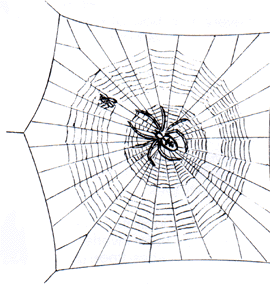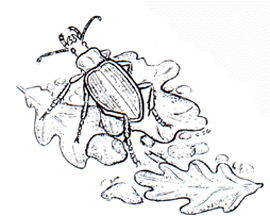What do Minibeasts Eat?
 Many invertebrates eat only plants, and they, like all plant-eating animals, are called herbivores. Many eat a wide range of plant food, especially leaves, but some feed on only fruit, nectar or pollen. Molluscs and insects are the only classes of invertebrates which have developed mouthparts capable of grinding up the tough tissues of green leaves. Grasshoppers and caterpillars have mouthparts with very sharp edges for cutting into leaves. Slugs and snails have a very efficient rasping organ called a radula, which is a bit like a conveyor-belt which tears up plant food.
Many invertebrates eat only plants, and they, like all plant-eating animals, are called herbivores. Many eat a wide range of plant food, especially leaves, but some feed on only fruit, nectar or pollen. Molluscs and insects are the only classes of invertebrates which have developed mouthparts capable of grinding up the tough tissues of green leaves. Grasshoppers and caterpillars have mouthparts with very sharp edges for cutting into leaves. Slugs and snails have a very efficient rasping organ called a radula, which is a bit like a conveyor-belt which tears up plant food.
The mouthparts of some insects are specially adapted for feeding on the sap and nectar of plants. Aphids e.g. greenfly and blackfly, have piercing mouthparts which draw up sap from a plant stem. Butterflies and moths have a long thin tongue (a proboscis) which they use to reach into flowers and suck out the nectar. When not in use the proboscis is curled up like a watch spring. Some butterflies enjoy the juice from rotting fruit.
Herbivorous minibeasts have to keep a watchful eye out for meat-eating minibeasts – the carnivores. For their size, carnivorous minibeasts are powerful and ferocious predators.. Some of them are active hunters, being able to move fast in pursuit of their prey, whilst others set traps to catch their victims.
 Some spiders are hunters and some are trappers. The wolf spider lies in wait, often among dead leaves on the woodland floor, ready to jump out and chase its prey.
Some spiders are hunters and some are trappers. The wolf spider lies in wait, often among dead leaves on the woodland floor, ready to jump out and chase its prey.
Other spiders spin webs with sticky threads to trap flying insects. Once the victim is trapped, the spider paralyses it with a bite. Then it wraps the insect in silk and injects it with enzymes that break down its body into a liquid which the spider can suck up.
 Ground beetles run fast on long legs and hunt at night. They have powerful, sharp jaws for grabbing and crushing other insects and slugs. There are 352 species of ground beetle in Britain, and most species are specially adapted for a life on the ground. Some, like the violet ground beetle, cannot fly as their wing cases (elytra) are joined together. During the day ground beetles hide under logs, stones and dead leaves.
Ground beetles run fast on long legs and hunt at night. They have powerful, sharp jaws for grabbing and crushing other insects and slugs. There are 352 species of ground beetle in Britain, and most species are specially adapted for a life on the ground. Some, like the violet ground beetle, cannot fly as their wing cases (elytra) are joined together. During the day ground beetles hide under logs, stones and dead leaves.
Dragonflies are specially adapted for hunting on the wing. They have enormous eyes and strong wings which help them spot and chase other flying insects. They can spot prey 12 metres away in almost any direction. To help them scoop up the prey in the air, their legs are spread out like a basket. Strong, biting mouth parts deal with the captured insect. Dragonfly larvae live in freshwater ponds and they are also carnivorous. In fact, there are several fierce carnivorous minibeasts to be found in ponds – diving beetle, water boatman, water scorpion and pond skater to name but a few.
Other predatory invertebrates on land include centipedes, harvestmen and several other species of beetles – ladybirds, soldier beetles and rove beetles.
Read More: Why are Minibeasts Important?